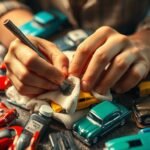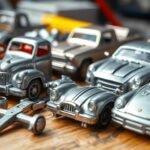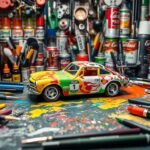Are you a diecast enthusiast trying to fix your favorite models? Fixing damaged diecast models can be tough but also very rewarding. In this guide, we’ll show you how to bring your broken diecast back to life. You’ll learn the secrets to fixing and transforming them.
Key Takeaways
- Master the art of diecast repair techniques to salvage your old diecast toys
- Discover the essential tools and materials required for restoring damaged diecast models
- Understand the importance of assessing damage and selecting the right solder for your diecast materials
- Learn step-by-step methods for addressing both cosmetic and structural issues in diecast restoration
- Explore strategies for maintaining your newly restored diecast models for lasting enjoyment
Understanding Diecast Materials and Damage Assessment
If you love collecting or enjoy diecast models, knowing about their materials and common damages is key. This knowledge helps in fixing chipped paint and broken parts. It’s the first step to bring back your favorite diecast models to their former glory.
Types of Common Diecast Damages
Diecast models face many cosmetic and structural problems over time. Some common issues include:
- Paint chips and scratches
- Fading or discoloration of the paint
- Broken or missing parts
- Structural damage, such as bent or warped frames
Essential Tools and Materials for Repairs
To fix your diecast models, you need specific tools and materials. Here are some must-haves:
- Model paints in matching colors
- Fine-tipped brushes for detailed work
- Superglue or epoxy resin for repairing broken parts
- Sandpaper in varying grits for surface preparation
- Spare parts, if available, for replacing damaged components
Safety Precautions During Restoration
When fixing your diecast models, safety comes first. Here are some important safety tips:
- Wearing protective gloves to avoid skin irritation from chemicals
- Working in a well-ventilated area to minimize exposure to fumes
- Carefully following the instructions on all product labels
- Disposing of any hazardous materials in accordance with local regulations
By knowing about common damages, getting the right tools, and focusing on safety, you can restore your diecast models. This way, you can show off their beauty again.
How to Fix Broken Diecast: Step-by-Step Techniques

If you love diecast cars, finding a damaged model can be heartbreaking. But, with the right steps, you can fix your vintage diecast collections. This way, your worn collectibles can look like new again.
First, figure out what’s wrong with your diecast car. Small issues like paint chips or scratches can be fixed with care. Clean the car well, then use matching paint to cover the damage. Make sure the paint is dry before touching the car.
For bigger problems, like broken parts, you’ll need to get a bit hands-on. Use strong adhesives like superglue or epoxy to fix broken pieces. If parts are missing, check online stores like eBay or contact the maker. Some, like Hobbymaster, are great at helping with replacements.
At times, you might need to do some metalwork to fix parts. Use the right tools and be careful, as metalwork can be tricky. With patience and the right skills, you can make your diecast cars look like new again.
“Repairing diecast models takes time and care, but the sense of accomplishment when you see your beloved car restored is truly priceless.”
Fixing diecast models requires careful preparation and attention to detail. Whether it’s small cosmetic fixes or bigger repairs, the right steps can make your vintage diecast collections shine. This way, your favorite models will stay in great shape for many years.
Conclusion: Maintaining Your Restored Diecast Models
Fixing diecast models might look hard, but it’s doable with the right tools and approach. It not only brings back your collectibles but also lets you learn new skills. For big problems, getting help from a pro might be needed, but taking care of them regularly can stop issues before they start.
Many makers offer great customer service and parts, which are super helpful for fixing models. Taking good care of and handling your restored diecast models right can make them last longer. This keeps their value high for many years. Always be patient and pay close attention to details when fixing broken diecast and using good repair techniques.
Now, you have the knowledge and skills to keep your diecast collection in top shape. Enjoy fixing and customizing these detailed models. Share your love for them with others in the lively diecast community.
FAQ
What are some common damages that diecast models can suffer from?
What essential tools and materials are needed for repairing diecast models?
How do I approach repairing cosmetic issues on a diecast model?
What steps should I take to fix structural damages on a diecast model?
Can I contact the manufacturer for replacement parts if I need specific components?
How can I maintain my restored diecast models to prevent future damage?
Source Links
- Soldering Diecast Model Cars – Iso-Tip – https://iso-tip.com/soldering-diecast-model-cars?srsltid=AfmBOorbsaXwb6IE70OCv3UcP83m_r_oJbiB5-m3TjtHcQ3WPfIprPom
- Restoration Handbook – The Vintage British Diecast Forum (VBD3) – http://www.vbd3.co.uk/viewtopic.php?t=29
- Best way to glue diecast? Or hold diecast together? – https://ogrforum.com/topic/best-way-to-glue-diecast-or-hold-diecast-together
- Design and Develoopment Sourcebook: Product Design for Die Casting – https://cwmdiecast.com/wp-content/uploads/2020/06/Die-Casting-Prod-Design-NADCA-min.pdf
- DIY Guide to Restoring & Customizing 1:18 Scale Die-Cast Model Cars – https://diecastcars.us/118-scale-diecast-model-cars/?srsltid=AfmBOopwsW13ntCa7curta3ueOiPTtHb376Dsastp3Zv-67Iva5KMfQ_
- PDF – https://www.enginsoft.com/bootstrap5/images/research/projects/futurities2023-4-agile.pdf
- Can Diecast Be Repaired | A Guide on How To Repair Diecast Metal Cars – https://www.model-car-world.co.uk/blog/post/Can Diecast Be Repaired A Comprehensive Guide to Repairing Diecast Cars
- Repairing diecast damage – DA.C – https://www.diecastaircraftforum.com/military-model-aircraft/320616-repairing-diecast-damage.html
- Diecast Repair Information and Diecast Tips. – http://www.jsssoftware.com/aspx/diecast_tips.aspx
- DIY Guide to Restoring & Customizing 1:18 Scale Die-Cast Model Cars – https://diecastcars.us/118-scale-diecast-model-cars/?srsltid=AfmBOor5KwoQ3aeRctC44Bqr-D9TP-Q7pjrTPV9-v1MrijOuqZ1URxt7








Interesting guide, but have you considered the environmental impact of these repairs compared to buying new diecast models? Just a thought.
The article says expert restoration guide but wheres the part about dealing with rusty diecast? A bit misleading, no?